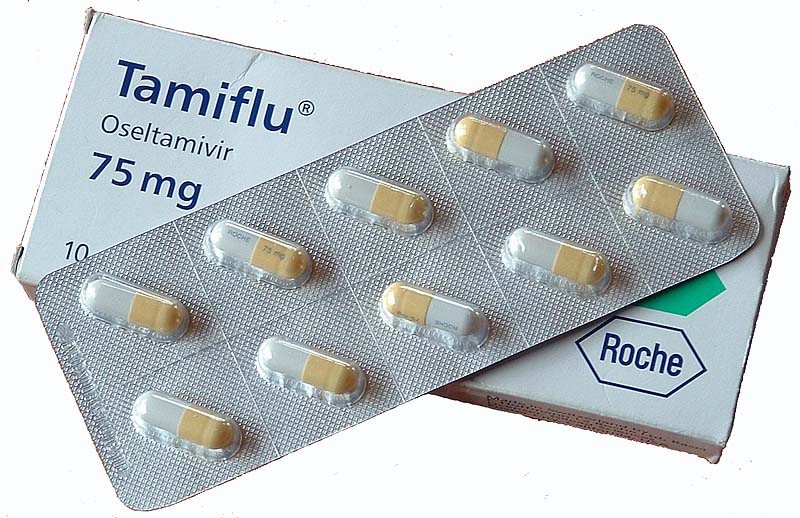Tamiflu and the Ethics of the British Medical Journal
 Last week, the UK media, both traditional and social, were full of claims that the government had wasted over £500 million of public funds on stockpiling Tamiflu (oseltamivir), an anti-viral drug used in the treatment of influenza. The claims derived from a paper published in the British Medical Journal (BMJ) by the influential Cochrane Collaboration. This story, however, tells us less about Tamiflu than about the circulation wars between leading medical and scientific journals, about the credulity of some science and medical journalists, about the exaggerated public expectations of modern pharmaceuticals, and about the Talibanization of the Cochrane Collaboration. If public and professional confidence in a moderately helpful drug has been damaged, it would not be a surprise if there are deaths to be laid at the doors of the BMJ and the Cochrane Collaboration.
Last week, the UK media, both traditional and social, were full of claims that the government had wasted over £500 million of public funds on stockpiling Tamiflu (oseltamivir), an anti-viral drug used in the treatment of influenza. The claims derived from a paper published in the British Medical Journal (BMJ) by the influential Cochrane Collaboration. This story, however, tells us less about Tamiflu than about the circulation wars between leading medical and scientific journals, about the credulity of some science and medical journalists, about the exaggerated public expectations of modern pharmaceuticals, and about the Talibanization of the Cochrane Collaboration. If public and professional confidence in a moderately helpful drug has been damaged, it would not be a surprise if there are deaths to be laid at the doors of the BMJ and the Cochrane Collaboration.
No one in this debate is entirely free of prior interests. What are mine? I was a member of ethical advisory panels to both the UK Department of Health (2006 onwards) and Roche Pharmaceuticals (2007-10), the manufacturers of Tamiflu. As with other private clients, the latter work was carried out under a confidentiality agreement. I do not have a problem with this, not least because I do not have a problem with the idea that large corporations are entitled to create a challenge function intended to alert them to potential issues with their strategy and products before these arise in the public domain. If that challenge is performed properly, then the issues do not arise and the corporation’s reputation is not unnecessarily damaged. I do not, in fact, need to refer to information received under that contract because it was entirely consistent with what I saw as a UK government adviser, although I will draw some personal conclusions from the experience.
In 2005, looking at the death rate — as high as 40 percent — among people who had caught the H5N1 influenza virus from birds in Asia, there was a genuine, and quite rational, fear of a 1918-style pandemic. The 1918 pandemic is thought to have killed well over 50 million people: modelling studies in the last decade suggest that a similar outbreak today would result in 80-100 million deaths.
In some respects, medical science has no more to offer now than it had in 1918. Although we can make vaccines, these take about six months to develop and test, so that, in a pandemic, many deaths would happen before they became available. We have palliative measures, like ventilators and ECMO, which may sustain life long enough for the victim’s immune system to respond to the infection — but these require specialist intensive care beds and staff, whose numbers are fixed in the short term, so that access will need to be rationed. Finally, we have a moderately effective therapy, in the form of a class of drugs known as neuraminidase inhibitors. Tamiflu is the most useful of these because it comes as capsules which can be taken orally, and are easily shipped and stored.
In the light of these concerns, the UK government, in parallel with many other developed countries, began to acquire a stock of Tamiflu in 2006. These supplies were drawn down during the 2009 ‘swine flu’ (H1N1) pandemic, and have since been partially replenished. In the light of clinical experience in 2009, the drug is also being used regularly to treat influenza in high-risk groups, although annual vaccination remains the primary strategy for prevention.
However, there has long been a real anxiety within the policy community that public expectations of Tamiflu would exceed what it could actually deliver. The BMJ is talking nonsense when it suggests that national governments were victims of a confidence trick by a wicked drug company. The policy community fully understood the limitations of the evidence and the likelihood that the benefits would be moderate. No insider ever thought it was a wonder drug.
There are good technical reasons for this. Although you might compare anti-virals to antibiotics, they work in a quite different way. Very crudely, if you have a bacterial infection, like scarlet fever, antibiotics attack the infectious agent directly and immediately. If you have a viral infection, like influenza, anti-virals disrupt the virus’s replication so that your own immune system has an opportunity to catch up and deal with it. This is why the benefits of anti-virals are so closely linked to the time at which treatment begins. If you start taking them within 48 hours after your symptoms appear, they can offer a significant benefit because the virus has only replicated to a limited extent: by containing its expansion, your immune system has a chance to get into top gear. After 48 hours, they are likely to be less helpful, because the virus has got further ahead, but they may still have some benefit, especially in patients with unresponsive immune systems.
Now it is a big ask for any health care system to get anti-virals into flu victims so quickly but all those involved accepted that that was the challenge. Anti-virals would not stop a pandemic, but they might slow its movement through the population and buy time for vaccine development. They might also help particularly vulnerable patients — the old, the very young, those with compromised immune systems or underlying respiratory conditions — by reducing the immunological challenge. Finally, and for governments this was a serious issue, on top of reducing deaths and hospitalisations, they might shorten the duration of absence from work. If the extrapolations from all three pandemics of the 20th century (1918, 1957, 1968) were correct, then one third of the population might be sick at some time in a 6-12 week period. How would a government keep the society going — the lights on, food in the supermarkets, streets cleared of rubbish, even ensure that the dead were buried? That is why pandemic influenza appears at the top of the UK government’s national risk register — and remains there despite the low severity of the 2009 pandemic. Politics or Sociology 101: The maintenance of civic order is fundamentally what government is about.
You might also think that there is a problem for any major corporation that possesses what the global population believe to be a unique solution to their distress, especially if they see other people sick and dying all around them. Maybe the ‘nice little earner’ suddenly becomes a poisoned chalice. Some governments have decided not to stockpile your product. Others could not afford to. You cannot ramp up production. What do you do with the contents of your warehouses? Is there any move you can make that does not leave you open to a charge of indifference to global suffering? Plenty of people, including the BMJ, would prefer to blame a wicked drug company than a failure of global health governance.
So what was the experience with Tamiflu in 2009? Coincidentally, a study of the use of this class of drugs — mostly Tamiflu use — was published in the respected Lancet Respiratory Medicine two weeks previously. This found that, in clinical use with almost 30,000 patients world-wide during the 2009 pandemic, the drug did rather more than the symptom reductions claimed from the manufacturer’s trials: it also reduced the death rate among patients who were ill enough to need hospital treatment by 20 percent overall — and by as much as 50% among those who started anti-viral therapy within 48 hours. Even where the therapy started later, there was still evidence of benefit. Would you have known this if you were not a regular reader of Lancet Respiratory Medicine? There was a press release but the journalists who were quick to run a bad news story two weeks later did not follow this up. Indeed, you could read virtually all the coverage of the BMJ paper without being told that an equally serious study had only just published contradictory results.
Here we have a very substantial study of real patients that adds to the body of evidence that Tamiflu is a moderately useful drug, with definite benefits in reducing mortality in some patients, being contradicted by another that says, according to the theory of the clinical trial, it does not work at all. Which one should we believe?
The BMJ is known to run a slick media operation so you might think this is just down to better promotion of their story — which still raises interesting questions about the extent to which modern journalists simply rewrite press releases. It may go a little further than that, however. The BMJ did subsequently publish a letter from Jonathan Nguyen-Van-Tam, principal investigator on the other paper, complaining about their breach of the usual protocol. An embargoed article had been forwarded to the Cochrane Collaboration to produce a statistical critique which was then puffed in a news piece by a BMJ staff journalist. Both critical comments were published in the same week as the original without any immediate opportunity for rebuttal. If you are not familiar with the etiquette of these things, accepted scientific practice would be for a critique to be submitted to the journal in which the original paper had appeared and, if accepted following peer review, to be published alongside a response from the original authors. Although Nguyen-Van-Tam does not make the point explicitly, there is a clear implication that the BMJ have set out to ensure that a paper published by a rival has been trashed in favour of their own. It would be extremely interesting to know what other exchanges went on between the BMJ, Lancet Respiratory Medicine, the authors of the Cochrane paper, and the journalists who cover this beat, perhaps before the Lancet paper was even published — but I suspect we are unlikely to find out.
We now come to the Cochrane article itself. Several other commentators have remarked on the way in which it confuses its meta-analysis with another agenda about the alleged bad behaviour of the global pharmaceutical industry. If you pick away at it, numerous problems do emerge with the original trial designs. Arguably a more honest approach would have been to acknowledge that the basic data were not robust enough to justify fancy statistical manipulations. However, this would be to discount the commitment of the latter-day Cochrane evangelists for taking the hammer of their statistical methods to every problem, even if it would be better suited to a screwdriver. In many ways, it reminds me of the sort of economist who complains that practice must be wrong because it does not fit the theory. Here we have a very substantial study of real patients that adds to the body of evidence that Tamiflu is a moderately useful drug, with definite benefits in reducing mortality in some patients, being contradicted by another that says, according to the theory of the clinical trial, it does not work at all. Which one should we believe?
I never had the good fortune to meet Archie Cochrane, although I know many people who did and I worked alongside some of the founders of the Cochrane Collaboration in Oxford in the 1980s. Cochrane’s own work would have an honoured place on my own bookshelf if a student had not wandered off with it in the past. He had a much better appreciation of the limitations of trials than many of his latter-day disciples: ‘Between the scientific measurements based on RCTs and the benefit measurements…in the community, there is a gulf which has been much underestimated…’. On any reading, Effectiveness and Efficiency is a more intellectually generous and less mean-spirited work than much of what has followed. This approach certainly informed the early years of the Collaboration, which now seems to bear about as much relationship to the teachings of the founders as the gospel of the Taliban does to the wisdom of the Prophet.
Where does this leave us? Firstly, Tamiflu almost certainly saved lives in 2009 — and will continue to do so if used appropriately in routine practice as a back-up to seasonal vaccination. Secondly, governments are still properly concerned about the risks of a major pandemic and, from their perspective, even a modest reduction in the severity and duration of illness is worth having for its wider benefits to maintaining economic and social functioning: £500 million is a small price alongside the potential hit to GDP from a 1918-style pandemic. Thirdly, further research and development in the field of anti-virals continues to be important, particularly in finding agents that will work more rapidly and more effectively. Finally, both the BMJ and the Cochrane Collaboration might engage in some soul-searching about the ethics of their actions. Has their evident desire for publicity, and an obsession with the supposed evils of the international pharmaceutical industry, perverted their scientific commitments? Is this really what ‘impact’ means for those who fund the Cochrane work? What is their responsibility for any deaths that may result from undermining public or professional confidence in the benefits of Tamiflu?
































































































I’ve been following a very interesting blog / discussion at http://www.rectofossal.com/tamiflu on this study – I think the author has upset the BMJ as they’ve been stung into responding!
http://www.rectofossal.com/tamiflu/ is a really good discussion and takes on the methodological issues in much more detail than I could do here.
One of the things that gave antivirals a bad name was the political drive behind the “containment” phase of the 2009 pandemic. Despite the evidence that antivirals are most effective if given promptly, and that systems were not able to provide them promptly, we had the ridiculous situation in the Midlands that HPA was obliged to provide antivirals to people, and to encourage them to take them, even though the systems were unable to get the drugs to them within a week of onset of symptoms. This served no useful purpose, but caused side-effects and risked driving resistance. It was… Read more »
Indeed, “you could read virtually all the coverage of the BMJ paper without being told that an equally serious study had only just published contradictory results”. Virtually, but not all. http://www.newscientist.com/article/dn25397-is-stockpiling-pandemic-flu-drugs-shrewd-or-misguided.html?full=true#.U00SPGeKCUk Please note statistical manipulation. Also relevant: http://www.newscientist.com/article/dn23744-evidence-that-tamiflu-reduces-deaths-in-pandemic-flu.html#.U00RyWeKCUk and the same group’s very similar attack in 2009. http://www.newscientist.com/article/dn18271-bmj-criticisms-of-tamiflu-questioned.html#.U00SF2eKCUk
Thank you, Debora. Very helpful.